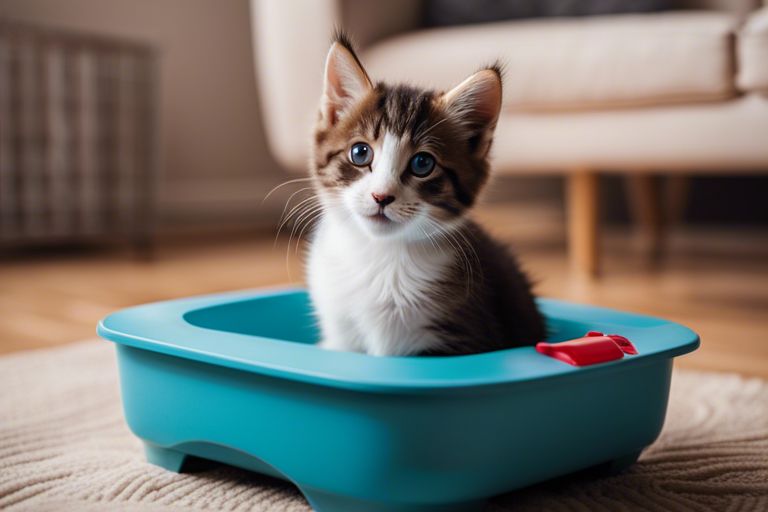Acclimating your feline friend to using a litter box may seem like a daunting task, but with the right approach, it can be a smooth and stress-free experience for both you and your cat. Consistency and patience are key when it comes to training a cat to use a litter box. Additionally, creating a comfortable and accessible litter box environment is essential in ensuring success. Here, we will discuss some tricks and tips to help you in the process of training your cat to use a litter box.
Key Takeaways:
- Consistency is key: Cats thrive on routine, so consistently placing them in the litter box after meals and naps can help create a routine for using the box.
- Choose the right litter: Cats have preferences for the type of litter they prefer, so experimenting with different textures can help find the right fit for your cat.
- Placement matters: Placing the litter box in a quiet, easily accessible location can help encourage your cat to use it regularly.
- Positive reinforcement: Rewarding your cat with treats or praise when they use the litter box can create a positive association and encourage them to continue using it.
- Address any issues promptly: If your cat is having trouble with the litter box, it’s important to address any underlying health or behavioral issues promptly to ensure they are comfortable using it.

Understanding Cat Behavior
Assuming the responsibility of teaching your cat to use a litter box requires an understanding of their natural instincts and behavior. Cats are independent creatures by nature, and their behavior can be influenced by various factors such as genetics, environment, and past experiences. By understanding their behavior, you can effectively train your cat to use a litter box and create a stress-free environment for both you and your feline friend.
Natural Instincts and Litter Preferences
Cats are naturally clean animals and prefer to eliminate in a clean and quiet environment. Understanding their natural instincts and litter preferences is crucial in successfully training them to use a litter box. Some cats may have specific preferences for the type of litter, such as clumping or non-clumping, scented or unscented. Additionally, the location and accessibility of the litter box play a significant role in your cat’s willingness to use it. By observing your cat’s behavior and preferences, you can create an environment that encourages them to use the litter box consistently.
Recognizing Signs of Readiness for Training
It is important to recognize the signs of readiness and willingness in your cat before beginning the training process. Some common signs include digging or scratching in a specific area, frequent visits to the same spot, or displaying discomfort or anxiety when eliminating outside a litter box. By being attentive to these signs, you can determine when your cat is ready to be trained and take the necessary steps to facilitate the process.
Selecting the Right Litter Box
After you have decided to litter train your cat, the next step is to select the right litter box. This is an important decision as the right litter box can make the process easier for both you and your cat.
Types of Litter Boxes
When it comes to selecting a litter box for your cat, there are various types to choose from. Some of the most common ones include covered litter boxes, open litter boxes, self-cleaning litter boxes, and disposable litter boxes. Covered litter boxes provide privacy for your cat but can trap odors, while open litter boxes are easily accessible but may lead to more mess. Self-cleaning litter boxes automatically remove waste, making maintenance easier, whereas disposable litter boxes are convenient for travel or if you prefer not to clean the box yourself. The size and material of the litter box are also important factors to consider.
| Covered litter boxes | Provide privacy but trap odors |
| Open litter boxes | Easily accessible but may lead to more mess |
| Self-cleaning litter boxes | Automatically remove waste, making maintenance easier |
| Disposable litter boxes | Convenient for travel or low maintenance |
| Size and material | Important factors to consider |
Choosing the Appropriate Litter
Choosing the right litter for your cat’s litter box is just as crucial as selecting the box itself. Clumping litter is popular for its convenience as it forms easy-to-remove clumps, however, it may not be suitable for kittens or cats that ingest litter. Non-clumping litter is a safer option for young cats and it’s better at controlling odors, though it may require more frequent cleaning. Understanding your cat’s preferences and needs is key when choosing the appropriate litter for their box.
Training Techniques
Your cat may need some help learning how to use a litter box, but with the right training techniques, they can get the hang of it in no time. Consistency, patience, and positive reinforcement are key to successfully teaching your cat to use a litter box.
Setting Up for Success
Before you start litter box training, make sure you have the right setup for your cat. Choose a litter box that is large enough for your cat to comfortably use and place it in a quiet, easily accessible location. It’s important to keep the litter box clean by scooping it daily and changing the litter regularly. Additionally, make sure to use a litter that your cat approves of. If your cat doesn’t like the texture or scent of the litter, they may avoid using the litter box altogether.
Step-by-Step Litter Box Training
When it comes to litter box training, it’s important to take things one step at a time. Start by placing your cat in the litter box after meals or naps, as these are times when cats are most likely to need to use the bathroom. You can also gently guide your cat’s paws in a digging motion to help them understand the purpose of the litter box. After your cat successfully uses the litter box, be sure to praise and reward them with treats to reinforce the behavior.
| Do: | Don’t: |
| Be consistent with the location of the litter box | Force your cat into the litter box |
| Keep the litter box clean | Use a covered litter box (some cats don’t like the enclosed space) |
By following these steps and being patient with your cat, you can successfully train them to use the litter box. Remember to remain calm and avoid punishing your cat for accidents, as this can cause them to associate the litter box with negative experiences.

Troubleshooting Common Issues
However, even with the best training methods, you may encounter some common issues when teaching your cat to use a litter box. If you’re struggling with any aspect of litter box training, consider seeking advice from the online community. A great resource is the How do I litter train my cat? : r/CatTraining thread on Reddit, where you can find valuable tips and support from experienced cat owners.
Addressing Accidents Outside the Litter Box
If your cat is having accidents outside the litter box, it could be due to a number of reasons. It’s important to thoroughly clean any soiled areas with an enzymatic cleaner to prevent re-marking. You may also want to consider placing additional litter boxes in different areas of your home, especially if you have a multi-level living space. Remember to observe your cat’s behavior and consult your veterinarian to rule out any potential medical issues.
Dealing with Litter Box Aversion
Some cats may develop aversion to their litter box for various reasons, such as dislike of the type of litter, the box itself, or its location. If your cat is avoiding the litter box, try experimenting with different types of litter and providing multiple litter box options. Make sure the litter box is placed in a quiet, accessible area, away from your cat’s feeding and sleeping areas. If the aversion persists, consider consulting with a professional cat behaviorist for personalized advice.
Maintaining Good Litter Box Habits
Lastly, it’s important to maintain good litter box habits to ensure that your cat continues to use the litter box without any issues. Consistency and cleanliness are key to maintaining a positive litter box experience for your cat.
Regular Cleaning and Maintenance
Regular cleaning and maintenance of the litter box are essential for your cat’s health and well-being. You should scoop the litter box at least once a day to remove waste and clumps. Failure to do so can lead to your cat refusing to use the litter box and choosing to eliminate elsewhere in the home. Additionally, you should completely empty and clean the litter box with mild soap and water at least once a month to prevent odors and bacteria buildup.
Adjusting to Changes and Aging
As your cat ages, and as changes occur in your household, it’s important to pay attention to how these factors may affect your cat’s litter box habits. Cats can become more sensitive to changes, including new litter, new locations, or changes in their environment. It’s important to make any changes gradually and with consideration for your cat’s comfort and preferences to avoid any issues with using the litter box.

Tricks for Teaching a Cat to Use a Litter Box
Taking this into account, it’s important to remember that patience and consistency are key when teaching your cat to use a litter box. Start by placing your cat in the litter box after meals and naps, and reward them each time they use it. Make sure to keep the litter box clean and easily accessible for your cat. If accidents happen, be sure to clean the area thoroughly with an enzymatic cleaner to remove any lingering scent. And most importantly, never punish your cat for not using the litter box as this can create further issues. With these tips and a bit of dedication, you can successfully train your cat to use a litter box.
FAQ
Q: How can I teach my cat to use a litter box?
A: It’s important to place the litter box in a quiet, easily accessible location. Show your cat the litter box and gently place them inside, allowing them to explore. Keep the litter box clean and use a high-quality, unscented litter. Reward your cat with treats or praise when they use the litter box.
Q: What if my cat refuses to use the litter box?
A: If your cat is not using the litter box, ensure it is clean and in a convenient location. Rule out any medical issues with a visit to the vet. Consider trying a different type of litter, or using a larger or covered litter box. Never scold or punish your cat for not using the litter box, as this can create further aversion to it.
Q: Are there any tricks for training an older cat to use a litter box?
A: For older cats, it may take more time and patience to train them to use a litter box. Start by placing the litter box in a familiar and quiet location. Encourage them to use the box by placing them in it at regular intervals, especially after meals or naps. If they have accidents, clean the area thoroughly and consider using a pheromone spray to attract them to the litter box.

Jayley, a devoted cat enthusiast, also writer for other cat blog as well. She aims to dedicated to providing comprehensive information, insights, and advice on everything you’d ever want to know about our whiskered companions.
